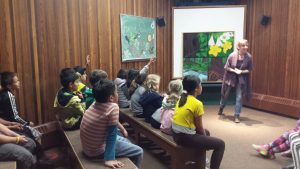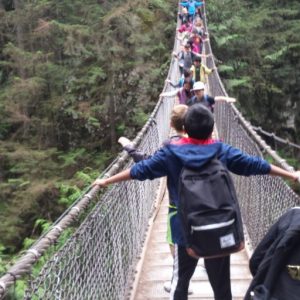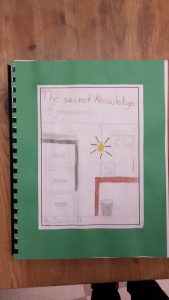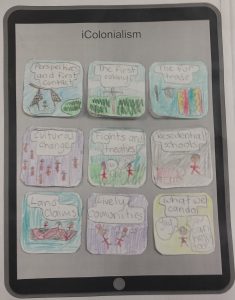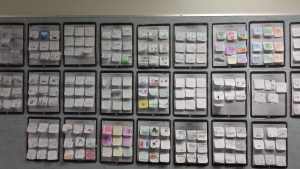Overview
During my education at the University of British Columbia, I had the pleasure of teaching a grade 4 class for my short and long practicums. I cherish the time I spent learning about my students as developing people with unique identities and strengths. I learned an incredible amount in a short year, and I can only hope that the themes and projects I guided my students through were as memorable to them as they are to me. I will present the highlights from this period, describing their curricular importance, process, and success on a classroom and personal level.
1. Hand-Painted Drums

Drying drums
As a cross-curricular project for art, music, and First Nations culture, I created a design so that each of my 30 students could make their own drum and drum stick for an overall cost of less than $100. We started with a story detailing the beliefs and uses of First Nations drums, and students then built the drums and drumsticks themselves. A lot of effort and dexterity was required to stretch the canvas, tie the handholds, wrap the drumsticks and paint the base layer. (Students knew that this is not the traditional construction of Aboriginal drums.) We learned about the artwork of Norval Morrisseau, an Ojibway artist, creating paper rough drafts after his style of a symbol that each student felt represented an important part of their life. We used acrylic paints for the images, which was a learning process for all involved on stain avoidance procedures! The students were excited for this project and produced exceptional work, though next time I would spend more time emphasizing the visual themes of Morrisseau’s work. Throughout the project, students wrote a journal entry on each session, detailing what they felt were the important take-away lessons.
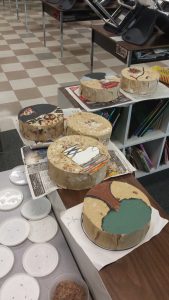
When the drums were finished, we used them in music class to learn some First Nations songs. I invited Davita Marsden, an Aboriginal enhancement teacher, to come and teach the Coast Salish Anthem to the class. I also taught The Loon Song on another occasion. The students loved using their drums to make music, with many reporting how they felt especially connected to the music when they played on a drum that they had created themselves. I believe that this project was worth all the effort, for the students were excited to use their drums and reported later on how they would use the drums at home to create songs of their own. Music to my ears! When I repeat this project with a future class, I will make sure to make them early in the year, because we did not have much time to use the drums in music class before practicum ended. I would like to have many sessions in which we can practice more songs and practice them multiple times in order to enhance the depth of learning of First Nations musical traditions.
2. Earth Day Song
To celebrate Earth Day, I compiled lyrics made by students during a brainstorm session about environmental conservation with the tune of the popular pop song, “Genghis Khan” by Miike Snow in mind. We performed the song for several younger classes, and the song was recorded and aired for the morning announcements.
3. Biome Boxes and Reports
In order to add a creative touch to science class while incorporating technology into the classroom, I had the students research a biome and then create a biome box that reflected its characteristics. The students were given multiple research periods on iPads, in which they searched various suggested science sites for the information they needed to write up a report on typical biome geography, location, species of plants, species of animals, and the interactions between animals and plants unique to that area. The students were highly engaged, often asking for the next session they could work on their box and wanting to work outside of class to make a masterpiece. I was amazed at the articulate reports and realistic representations that abounded in this assignment. I am happy I decided to add an artistic component to our unit on biomes, because I think the students were far more engaged than if I had simply assigned a dry written report. What made this project most successful was the multimodality with with the students could communicate their learning, for even the students who wrote less fluently were able to demonstrate what they knew about their biome through the tactile creation of the biome. The project culminated in a gallery walk with our grade 1 buddy class coming in to see the kind of work they can look forward to as older students. The kids had lots of fun showing off their hard work, and the young ones were impressed!
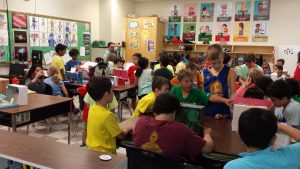
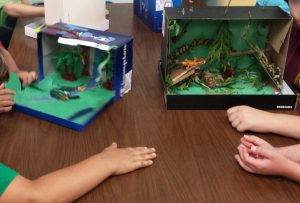
4. Growth Mindset
In a series of lessons aimed to introduce the students to the idea of growth mindset, I gave written assignments and art as a bonus project to explore the themes. In the written portion, the children wrote a letter to their future selves about a time they struggled in learning and how they overcame this dilemma. In the art portion, some stuents drew neurons connecting to each other after the style of Norval Morrisseau. It was really cool to see how some of the art pieces actually managed to connect to each other too! The result became an inspirational wall piece that I would often point to when reminding students that is wasn’t that they “couldn’t” do something, they just didn’t know it yet.
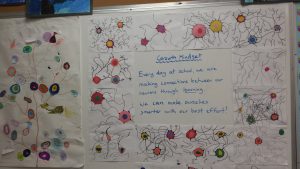
5. “The Secret Knowlege of Adults” writing assignment
What better way to interest children in writing than to explore inventive reasons behind all those darn rules adults like to make for them? In a mini-unit on writing using descriptive language, I read aloud the children’s book The Secret Knowledge of Grown-Ups by David Wisniewski, which contains many hilariously fictional accounts on the reasons certain rules exist. I then whipped up a template for a rough draft and final copy that the children used to write their own descriptive account on the reason behind one rule of their choice. The imaginations went to work, peer and teacher edits came into play, and in short order all the students had a submission for our very own classroom version of a book of rules.
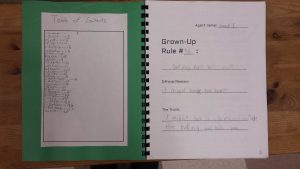
6. iColonialism
This project was wonderful social studies project in theory, but difficult in practice. There are nine summary “apps” that the students write using the most important themes from each information session on a theme concerning the effect of colonialism on First Nations peoples and settlers. I had the students read the textbook and in the beginning I showed them the parts that I considered most important take aways from the whole text. I gradually gave the students more independence by having them highlight key sections on photocopied sections of the textbook, discussing in groups first and then individually assessing important content for themselves. Students became much more excited about this project at the end when we put it all together, gluing all the apps onto the large template and drawing title pages for each concept. Next time, I think the students will stay engaged throughout the project if I have them complete each app individually and glue it on by a certain due date, and then they can see the progress and direction of the project more clearly.
7. Field Trip to Lynn Canyon Park
To add an authentic spin on our biomes science unit, I organized a trip to Lynn Canyon Park in order for the students to learn different characteristics of the temperate rainforest biome. Prior to the trip, the students learned about the matter cycles and types of species that are common to our local biome. We visited the Lynn Canyon Ecology Centre and hiked through the park on a scavenger hunt to find different examples of decomposers, primary producers, and consumers. My greatest hope was that students would be inspired to return and spend more time learning about their local biome, and I am happy to report that many students told me that they planned to come back with their families and explore even more!
